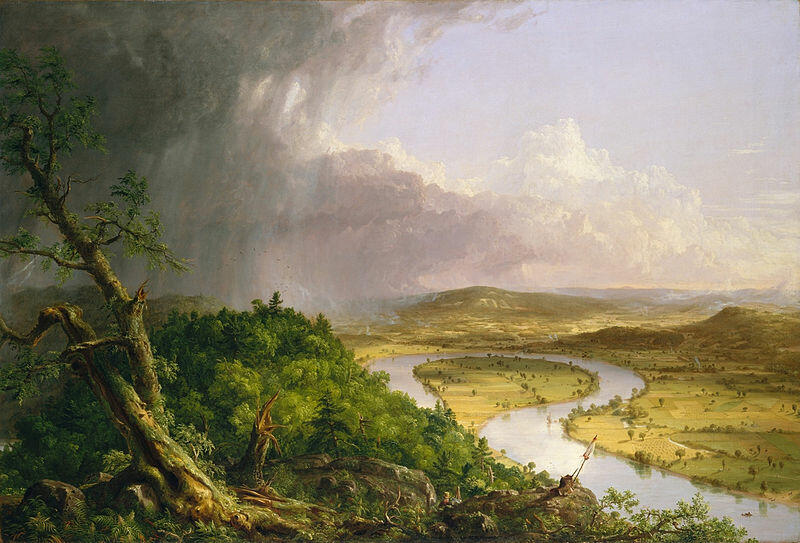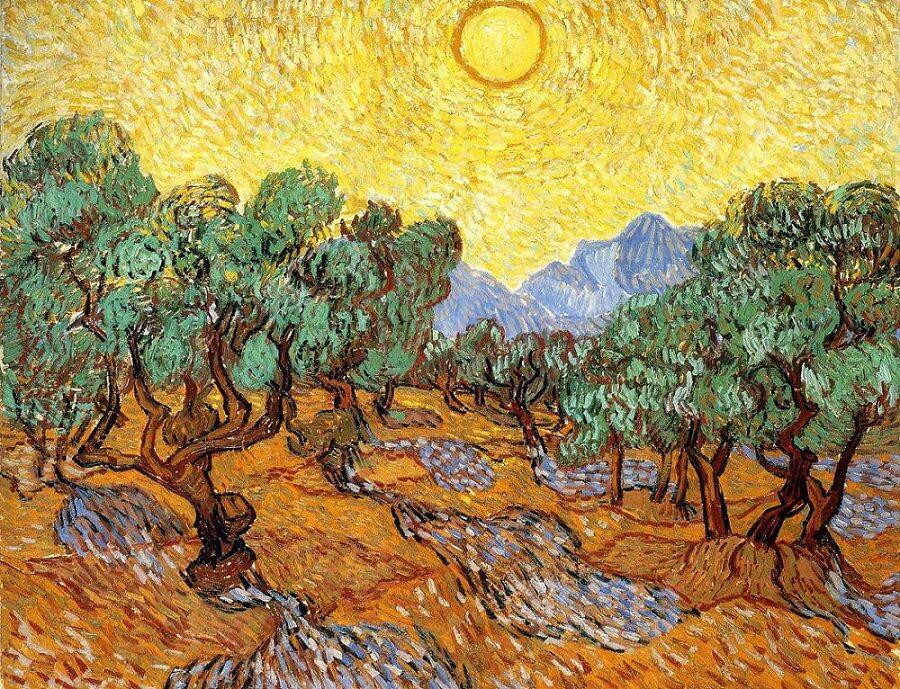Introduction
Many painters from different movements have managed to produce admirable works that glorify God’s creation and guide people to address most of the social, economic, political, and psychological issues they face in their lives. Some of the famous painters of the 1800s whose artworks continue to attract the attention of many scholars, historians, environmentalists, and researchers include Thomas Cole and Vincent van Gogh. The comparative paper below uses the paintings, The Oxbow and Olive Trees with Yellow Sky and Sun in an attempt to understand the beauty of nature and how they manifest God.
Comparing and Contrasting the Two Artworks
Thomas Cole painted the work of art, The Oxbow in the year 1836. The painting is presented below and depicts a seminal landscape of the Connecticut River Valley. Kennicott believes that the artist intended to portray the confrontation between human civilization and wilderness that existed during the early 19th century. On the right side, the viewer observed a cultivated landscape that appears quiet or calm. On the left is an untamed wilderness that has not experienced any form of human interference.
The viewer can identify logging scars in the nearby forest. With this kind of observation, it is evident that any human activity has the potential to affect or disorient the integrity of the natural environment, including cultivation. The word “Shaddai” is observable when one views the painting upside down. Since the true meaning of this term is “The Almighty”, many people acknowledge that the artist wanted to proclaim God’s greatness using his productions.

Vincent van Gogh observed the nearby olive trees, wheat fields, and cypresses while he was in an asylum in 1889 to produce the painting, Olive Trees with Yellow Sky and Sun. According to Jones, this artist was always willing to depict olive trees in most of his works. In the artwork presented below, the painter demonstrated the unique relation existing between nature and man successfully. He also tried to analyze the cycles of life. This means that van Gogh was keen to connect with nature through the use of artworks. Jones goes further to indicate that van Gogh produced this work at a time when he was seriously ill. However, it was during this period when he managed to produce some of his finest or admirable paintings.

From this analysis, it is evident that these two artists produced their works in different artistic periods. Thomas Cole’s The Oxbow is associated with the Romanticism movement while van Gogh’s Olive Trees with Yellow Sky and Sun belongs to the Post Impressionism movement. In the first work, the painter used most of the features of the Romanticism movement, including rich colors and fading brush strokes (Kennicott). In the second painting, the artist relied on the power of formal order, symbolic content, and structure to deliver the intended message to the viewer. Analysts usually consider these unique differences in an attempt to have a clear understanding of these artworks.
Despite the outlined distinctions, the selected paintings capture the beauty of the natural environment. Both artists achieve this aim by depicting different aspects of God’s creation. They go further to illustrate how human activities affect the integrity of nature. This results in a unique kind of disharmony that all people should take into consideration. These similarities explain why individuals find these paintings meaningful and admirable (Ellison 273). Consequently, scholars have continued to study and analyze these works of art to have a better understanding of nature.
The Beauty of Nature
As indicated above, the selected paintings try to portray the beauty of nature from a critical perspective. The artists use the theme of sublime to glorify God’s creation. In the first work, Cole presents violent clouds, tree trunks, rugged cliffs, and a dark wilderness. He also illustrates the Connecticut River in this work. He goes further to contrast such natural features with the cultivated land on the right side (Kennicott). This kind of dichotomy appears to describe the existing beauty of nature. The artist uses this form of contrast to explain how and why human activities are capable of affecting the integrity of this environment. The complexity and nature of the landscape support a theme of sublime, thereby glorifying God’s creation and encouraging human beings to protect it.
In van Gogh’s painting, the viewer observes that the portrayal of the intended olive trees is quite enthusiastic. This approach presents a strong sense of feeling or emotion. The artist also uses intense content and formal structure to impart the intended undulation to the sky, the sun, and the trees. A theme of sublime is, therefore, evident since van Gogh uses natural elements and features as sources of his emotional strength (Jones). This kind of portrayal also encourages him to think deeper or revisit his religious views and ideas.
In such olive fields and orchards, van Gogh found meaning and understood the true meaning of human life. Since he was ill during the period, the painter was convinced that a reexamination of the beauty of nature would result in happiness and empower him to remain unshaken (Ellison 276). In the artwork, he acknowledges that the beauty of the natural environment manifests God and encourages people to appreciate all cycles of human life. The sun, the sky, the olive fields, and the wheat fields remind viewers about the greatness of God’s creation.
From the two works of art, it is evident that the painters pursue a theme of the sublime by examining the beauty of God’s creation. They also show cultivated lands to explain how human activities have the potential to disorient nature’s beauty. This kind of portrayal should, therefore, encourage or sensitize human beings to promote evidence-based initiatives that have the potential to safeguard the environment for posterity. Additionally, the analyzed artworks can guide individuals to interact with their natural surroundings in an attempt to streamline or transform their spiritual ideas (Jones). Those who are facing challenges in their lives should also consider the thoughts or insights these great painters offer in an attempt to find solace and eventually lead better lives.
Conclusion
The above discussion has indicated that artworks by Vincent van Gogh and Thomas Cole pursue a theme of sublime. Even though the works belong to different artistic movements, the painters’ depiction of nature is an approach that makes it easier for them to glorify God. They also reveal that human activities have the potential to disorient the existing harmony in God’s creation. This means that people should always relate positively with nature to find God’s meaning in it, transform their spiritual ideas, and eventually achieve their potential in life.
Works Cited
Ellison, Aaron M. “Preserving the Picturesque: Perceptions of Landscape, Landscape Art, and Land Protection in the United States and China.” Land, vol. 3, no. 1, 2014, pp. 260-281.
Jones, Jonathan. “Vincent van Gogh: Myths, Madness and a New Way of Painting.” The Guardian, 2016.
Kennicott, Philip. “Did America’s Great Landscape Painter Fear Progress and Hate Democracy?” The Washington Post, 2018. Web.